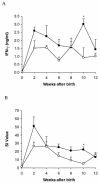Revaccination of neonatal calves with Mycobacterium bovis BCG reduces the level of protection against bovine tuberculosis induced by a single vaccination
- PMID: 14573662
- PMCID: PMC219550
- DOI: 10.1128/IAI.71.11.6411-6419.2003
Revaccination of neonatal calves with Mycobacterium bovis BCG reduces the level of protection against bovine tuberculosis induced by a single vaccination
Abstract
Cattle may provide a suitable model for testing ways of improving tuberculosis vaccine efficacy in human infants. A vaccination and challenge study was undertaken in calves to determine the optimal time to vaccinate neonatal animals with Mycobacterium bovis bacillus Calmette-Guérin (BCG) for protection against tuberculosis and to determine whether revaccination with BCG was beneficial. Calves (10 per group) were vaccinated with BCG within 8 h of birth or at 6 weeks of age, when immune responses to antigens of environmental mycobacteria were detectable, or vaccinated at birth and revaccinated at 6 weeks. A control group was not vaccinated. BCG vaccination at birth induced strong antigen-specific gamma interferon (IFN-gamma) and interleukin-2 (IL-2) responses and antigen-specific activation in CD4(+), CD8(+), and WC1(+) gammadelta T-cell subsets from blood. The proportions of animals per group with macroscopic tuberculous lesions after challenge were 0/10 for BCG at birth, 1/9 for BCG at 6 weeks, 4/10 for the revaccinated group, and 10/10 for the nonvaccinated group. There was no significant difference in the levels of protection between groups vaccinated at birth or at 6 weeks, while animals vaccinated both at birth and at 6 weeks had significantly less protection than those vaccinated only at birth. The revaccinated calves that subsequently developed tuberculous lesions had significantly stronger IFN-gamma and IL-2 responses to bovine purified protein derivative after the BCG booster than those in the same group that did not develop lesions. The results indicated that BCG vaccination at birth induced a high level of immunity and that the sensitization of very young animals to antigens of environmental mycobacteria by 6 weeks of age did not affect the effectiveness of BCG. However, BCG revaccination of these young animals was contraindicated.
Figures




References
-
- Andersen, P. 2001. TB vaccines: progress and problems. Trends Immunol. 22:160-168. - PubMed
-
- Barrios, C., P. Brawand, M. Berney, C. Brandt, P. H. Lambert, and C. A. Siegrist. 1996. Neonatal and early life immune responses to various forms of vaccine antigens qualitatively differ from adult responses: predominance of a Th2-biased pattern which persists after adult boosting. Eur. J. Immunol. 26:1489-1496. - PubMed
-
- Beverley, P. C. L. 1997. Vaccine immunity. Immunol. Today 18:413-415. - PubMed
-
- Bloom, B. R., and P. E. M. Fine. 1994. The BCG experience: implications for future vaccines against tuberculosis, p 531-557. In B. R. Bloom (ed.), Tuberculosis: pathogenesis, protection, and control. American Society for Microbiology, Washington, D.C.
-
- Brandt, L., J. F. Cunha, A. W. Olsen, B. Chilima, P. Hirsch, R. Appelberg, and P. Andersen. 2002. Failure of the Mycobacterium bovis BCG vaccine: some species of environmental mycobacteria block multiplication of BCG and induction of protective immunity to tuberculosis. Infect. Immun. 70:672-678. - PMC - PubMed
Publication types
MeSH terms
Substances
LinkOut - more resources
Full Text Sources
Medical
Research Materials

